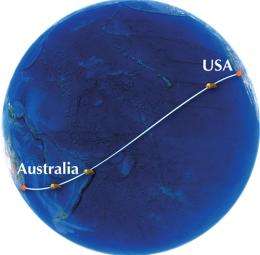Cables spanning Pacific ocean seafloor to give ocean science a new edge

Scripps researchers, NOAA and TE SubCom agree to pursue science ports on transcontinental fiber optic cable lines to help monitor earthquakes, tsunamis and other forces.
Marine scientists and a commercial telecommunications company are exploring partnerships that could dramatically advance scientists’ ability to observe and study ocean processes, provide early alerts for potential disasters and study deep Earth geodynamics.
Scientists from Scripps Institution of Oceanography at UC San Diego and engineers at NOAA’s Pacific Marine Environmental Laboratory (PMEL) are in the initial discussion stages with Morristown, N.J.-based TE SubCom, a TE Connectivity Ltd. company and an industry pioneer in undersea communications technology, to integrate scientific instruments onto thousands of miles of seafloor communication cables across the Pacific Ocean. The data collected will be open and available to the global scientific community.
“This is the first time a commercial telecommunications company’s cable installations will be deployed with embedded science sensors,” said John Orcutt, a distinguished professor of geophysics at Scripps and one of the leaders of the project. “It provides us with a whole new world of capability.”
The exploratory partnership between Scripps researchers, NOAA and TE SubCom is in the formative stages seeking funding for engineering and operations and looking at new approaches to collect high-bandwidth ocean data from the seafloor.
“This is an exciting opportunity to launch a new direction in subsea telecommunications, as there is significant potential in opening up data and power connectivity along undersea cables,” said Mark Englund, managing director, TE SubCom. “TE SubCom has a solution for ocean connectivity with unprecedented performance-to-cost ratios, and together with Scripps and PMEL, we have the right ingredients to make cable-based ocean connectivity a reality in every major ocean.”
The initial project is envisioned to focus along a cable route spanning 12,950 kilometers (8,105 miles) from Sydney to Auckland and across the Pacific Ocean to Los Angeles. Initial efforts are exploring the use of seismometers, pressure gauges and temperature sensors for hazard warning and mitigation. As funding develops, sensors could be deployed on future cables for the first time at 75 kilometers (47 miles) spacing. The sensors could allow NOAA scientists to measure the size and direction of tsunamis propagating across the ocean more precisely and to alert disaster management officials and first responders more quickly. The installation on the seafloor cable has the potential to greatly reduce long-term costs for tsunami monitoring, while at the same time dramatically increasing sensor density, accuracy and reliability.
“We’ve seen an unprecedented number of large and devastating tsunamis over the last several years,” said Christopher Sabine, Director of NOAA-PMEL. “We must explore new approaches for improving tsunami detection at lower costs while maintaining our existing capabilities.”
The fiber optic cable is capable of transmitting data at a maximum of 40 gigabits per second from deep-sea locations where gaps of instrument coverage currently exist. For comparison, the entire print collection of the Library of Congress could be transmitted over the link in just more than 30 minutes.
“More than 70 percent of the world is water and we need to understand much more of it,” said Orcutt, a scientist at the Cecil H. and Ida M. Green Institute of Geophysics and Planetary Physics at Scripps. “If this project expands to other oceans it could change the face of oceanography.”
The collaborators hope the academic-government-industry project will create a handful of new jobs, primarily in data management and near-real-time analysis, while providing the scientific community with an invaluable stream of data.
In addition to seismometers and pressure gauges, the scientific ports along the cable line could eventually include a comprehensive suite of sensors such as climate instruments (acoustic tomography and water column temperature and conductivity, for example) to measure ocean warming.
“We strive to explore new ways of observing the ocean that are innovative as well as cost-effective. This three-way collaboration between academia, government and industry could change the way we work,” said Sabine.
Scripps research geophysicist Frank Vernon, deputy director of the NSF Ocean Observatories Initiative Cyberinfrastructure program, is expected to use seismological data from the project to supplement details of Pacific Ocean earthquakes and develop deep images across the Pacific that presently are not possible.
“Currently we don’t have enough seismometers out there, so this effort will help us better understand the world beneath us,” said Vernon. “This includes our understanding of the plates, the interfaces inside the Earth and structural components from the crust down to the core.”
Provided by University of California - San Diego

















